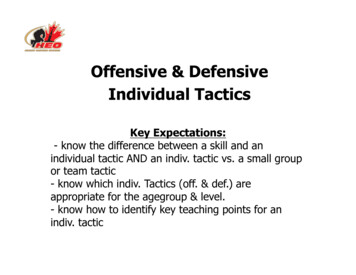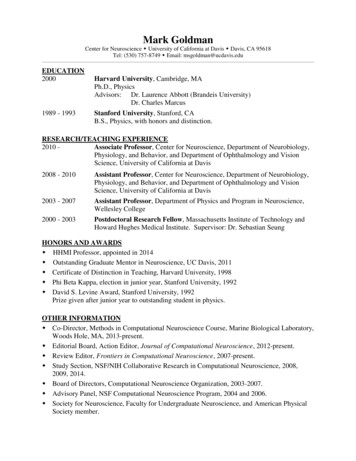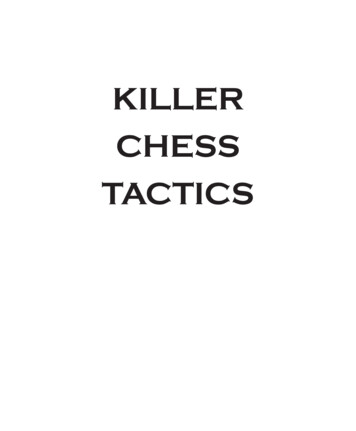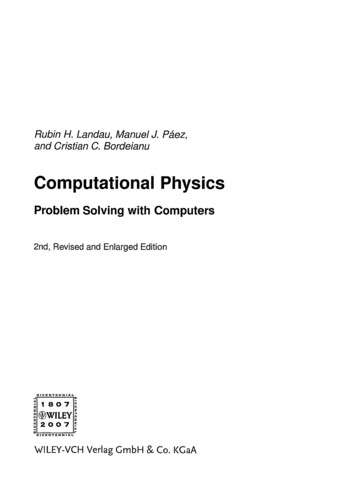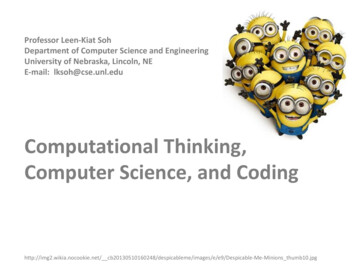
Transcription
Project TACTIC: Teaching All ComputationalThinking through Inclusion and CollaborationTACTICal Teaching BriefHelpful Strategies for Peer Collaborationduring K-12 Computer Science Instruction
IntroductionResearch on collaborative learning has shown that, when done well, it can promote cooperationand improve academic achievement for a broad range of learners in K-12 classrooms (Barkley,Cross, & Major 2014). Computer science (CS) education is often highly collaborative because ofthe focus on creativity and finding solutions to ambiguous or ill- defined problems. Thus, the K- 12Computer Science Framework counts collaboration as one of the core computing practices (K-12CS Framework, 2016).In engaging our students in collaborative learning within CS education, we seek to promote thefollowing behaviors:»»»»»»Maximize interactions so that students reach their desiredlearning goals.Promote opportunities for interdependence where eachmember’s efforts are valued.Provide explicit supports and strategies to encourageindividual accountability.Set up the classroom environment to be conducive tostudent interactions.Model and encourage interpersonal and social group skillsFigure 1. Computing Practices (k12for students with varying communication and collaborationCS Framework, 2016)strengths and challenges.Facilitate group processing to reflect on the collaboration as well as the CS education content.ScenarioMr. Gibson is a 3rd grade teacher who has integrated CS education into his classroom corecurriculum. Three students with disabilities are included in his 3rd grade class. Ms. Robbins, aparaeducator, provides support for these students during these CS education lessons.1. Rachel has a learning disability related to math;2. Roberto has a social communication disorder that kept him from verbally expressing hisneeds; and3. Connie has an emotional behavior disorder as well as a speech/language impairment andoften does not interact with her peers.Mr. Gibson noticed that each of these students had different challenges related to collaboratingwith their peers during the CS activities. He also noticed that some of the students withoutdisabilities also struggled with collaboration.
1. Although Rachel does collaborate with her peers, that collaboration often is not productivebecause she is often taken out of CS class to receive her IEP-related services and misses agreat deal of content.2. Roberto has significant challenges with communication and often becomes frustrated whenhe cannot express his need for help or confusion about the CS content.3. Connie has strong CS skills due to a personal interest in computer science and video games.However, because she typically sits in an assigned seat that is away from her peers, she doesnot often have opportunities to interact with others. Consequently, even though she has agreat deal of knowledge and experience in CS, her lack of interpersonal skills keep her fromhaving more productive interactions with her peers.Ms. Robbins suggested that Mr. Gibson meet with Ms. Gomez, the special education teacher, aswell as Ms. Hightower, the speech/language pathologist to help address the challenges describedabove. With the support of these professionals, Ms. Robbins and Mr. Gibson hope to capitalize onthe strengths of these students to help them collaborate more effectively during the CS educationactivities.Do any of these challenges sound familiar?Can you relate to any of these?Common Challenges»Paraeducators are often “assigned” to working with morethan one student. These students are frequently seatedtogether the back or side of the room, away from their peers,and have limited access to collaborative opportunities.»Many students consistently ask their peers for help, leavingthem stuck in the disempowering role of constant helpseeker.»Some students with and without disabilities want tocollaborate with their peers but lack the understanding ofhow to engage in productive discourse (such as effectivehelp-seeking), leading them to either avoid collaboration orbecome overly frustrated.»Students who seek help from or collaborate with otherslack the knowledge of how to do so effectively, leading tocontinued frustration.»Often, student collaboration veers off topic or becomesunproductive.
Strategies for Encouraging Peer Collaboration1. Create a classroom environment conducive to collaboration.»Consider the arrangement of the classroom, how students are seated, and classroom rulesin regards to where and how students work. For example, desks placed in rows inhibitmovement necessary for productive discourse with anyone other than immediate peers.Additionally, students’ “seats” do not have to be permanent. They can move based onactivity and collaborative preference.»Place anchor charts with “rules and roles” of collaboration in prominent places.2. Explicitly teach and model collaboration (Initially, collaborationmay be a distinct learning goal and not just a means to an end).»Encourage collaborative dialogue that provides students with language to assist them inseeking and giving help.»Model this language and the productive interplay between peers (e.g., effective ways ofasking for help and giving support in ways that promote independence). This is essential inassisting students with disabilities to articulate a problem and receive aid constructively.»Teach specific language and prompts to use as part of this process. Students often benefitfrom helper language, such as sentence stems, that enable them with linguistic tools tounpack a problem as they search for its solution with a peer.3. Explore different models of collaboration to best meet the needs ofall students.»Implement different collaborative models. Some students work better in less structuredhelp-seeking/supportive collaborative models. Others work better with more structured,assigned roles. If using assigned roles, be sure to vary the roles regularly so that studentsare not repeatedly performing the same task.»For instance, if utilizing pair programming, a timer can be used to signal students in thedyad to switch at regular intervals from working as the driver or navigator.»Consider the individual strengths and needs of students when assigning collaborativetasks, and monitor to make sure the student is involved and contributing.»Evaluate how individual work can be balanced with collaborative problem solving to meetthe needs of students resistant to collaboration.
4. Remind students to use the collaboration strategies introduced inclass and offer feedback on the use of those strategies.»Use priming phrases, such as, “remember that your friends are helpers too!” or “Please ask forhelp from a friend before coming to me.” These initial reminders are sometimes necessary tohelp students see opportunities for collaboration.»Prompt students to use previously taught strategies such as “Remember to use theCollaboration Discussion Framework” (Lash & Park, 2014).5. Utilize anchor charts and other aids to help scaffold collaborativebehaviors.»Display anchor charts with prompts and helper language prominently and reference theseaides when modeling the collaborative process.»Integrate checklists for individual roles into assignments or give them to students to use asa reference or self-monitoring strategy. Checklists also keep students moving forward inmeeting all goals for the lesson.6. Empower and encourage situations where students independently beginand maintain effective collaboration through specific feedback andpraise.»Encourage students to share their CS experiences. These conversations can spark ideas orresult in further productive conversation and innovation.7. Consider engaging your students in cross-age collaborations or peertutoring.»Cross-grade collaborations, often referred to as buddy classes, have long been used asa type of peer tutoring for reading, allowing older students to work with and model foryounger students (Newell, 1996).»Encourage opportunities for students to reinforce their own learning while engaging in thedevelopment of supportive relationships with individuals possessing diverse perspectives,skills, and personalities. The personal nature of these partnerships can result in a highdegree of engagement.»Consider student strengths, and needs when forming dyads.
Collaborative Discussion Framework (CDF) is one such tool:What are you trying to do?»Do they have or understand the purpose?What have you tried already?»Restate in steps what they have already done.What else do you think you can try?»Brainstorm, encourage students to take a chance.What would happen if.?»Come up with some possible solutions and hypothesize the outcomes. Test each hypothesis.Celebrate & Share!!»Take charge of celebrating one’s excitement.SummaryAfter working with the instructional team, Mr. Gibson is beginning to see major shifts in thecollaboration among students while they work on CS education projects.Ms. Robbins has moved students, including Connie, from a table in the back of the room and isworking with them as they are heterogeneously grouped with their peers. They now have greateropportunities for interaction and to work collaboratively.Although Rachel is still pulled from class to receive her IEP-related services, when she returns,she can still benefit from the many classroom anchor charts posted around the room related tocollaboratively working on CS education projects. Mr. Gibson has also made arrangements withRachel and her partner so that they can continue project work in their flex time.Roberto is collaborating more effectively due to the entire instructional team’s commitment tomodeling collaborative language and behaviors. While collaboration is still challenging for him, theuse of the Collaborative Discussion Framework has provided him with the tools to productivelyengage with his peers around CS education activities.
CitationsBarkley, E. F., Cross, K. P., & Major, C. H. (2014). Collaborative learning techniques: A handbook forcollege faculty. San Francisco, CA: Jossey-Bass.Israel, M., Wherfel, Q., Pearson, J., Shehab, S., & Tapia, T. (2015). Empowering K-12 students withdisabilities to learn computational thinking and computer programming. TEACHING ExceptionalChildren, 48(1), 45-53.K–12 Computer Science Framework. (2016). Retrieved from http://www.k12cs.org.Newell, F. M. (1996). Effects of a cross-age tutoring program on computer literacy learning ofsecond-grade students. Journal of Research on Computing in Education, 28(3), 346-358.Park, M., & Lash, T. (2014). The Collaborative Discussion Framework. Champaign Unit 4 SchoolDistrict.Sencibaugh, J. M., & Sencibaugh, A. M. (2016). An analysis of cooperative learning approaches forstudents with learning disabilities. Education, 136(3), 356-364.Funding for this research was provided by the National ScienceFoundation (award #1639837). Any opinions, findings, conclusions, orrecommendations expressed in this material are those of the authorsand do not necessarily reflect those of the NSF.For More Information, please contact:Maya Israel at misrael@coe.ufl.eduContributing authors to this TACTICal Brief:Todd Lash, Gakyung Jeong, Quinn Wherfel, and Maya Israel
a reference or self-monitoring strategy. Checklists also keep students moving forward in meeting all goals for the lesson. 6. Empower and encourage situations where students independently begin and maintain effective collaboration through specific feedback and praise. » Encourage students to share their CS experiences. These conversations can .
